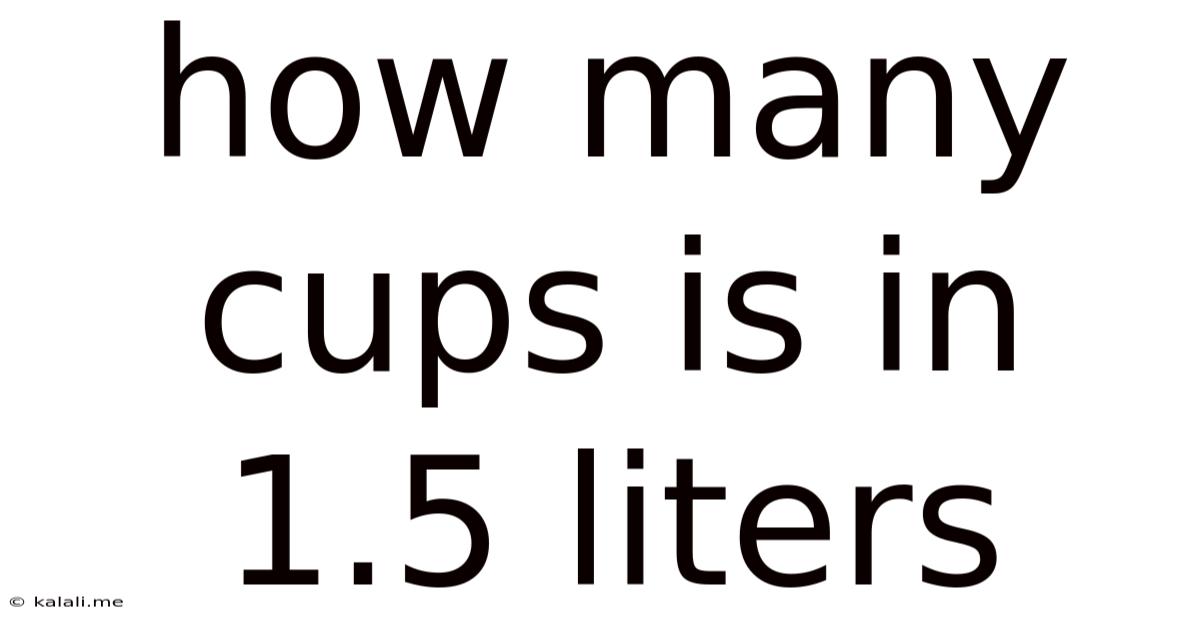How Many Cups Is In 1.5 Liters
Kalali
Jul 07, 2025 · 4 min read

Table of Contents
How Many Cups is in 1.5 Liters? A Comprehensive Guide to Liquid Conversions
So, you're faced with a recipe that calls for 1.5 liters of liquid, but your measuring cups are in cups, ounces, or maybe even milliliters. Don't worry, you're not alone! Converting between liters and cups can be confusing, but this comprehensive guide will walk you through the process, provide you with the answer, and equip you with the knowledge to handle similar conversions in the future. We'll delve into the exact conversion, explore different cup sizes, discuss the importance of accuracy in cooking and baking, and offer helpful tips for future conversions.
Understanding the Conversion: Liters to Cups
The simple answer is that 1.5 liters is approximately equal to 6.34 US cups or 5.05 UK cups. However, understanding the nuances behind this conversion is crucial for accurate measurements. The difference between US and UK cups stems from variations in their standard volumes. We'll explore this further below.
This conversion relies on the following fundamental equivalencies:
- 1 US cup = 236.59 milliliters (mL)
- 1 UK cup = 284.13 milliliters (mL)
- 1 liter = 1000 milliliters (mL)
Therefore, to convert 1.5 liters to US cups:
- Convert liters to milliliters: 1.5 liters * 1000 mL/liter = 1500 mL
- Divide milliliters by milliliters per US cup: 1500 mL / 236.59 mL/cup ≈ 6.34 US cups
And to convert 1.5 liters to UK cups:
- Convert liters to milliliters: 1.5 liters * 1000 mL/liter = 1500 mL
- Divide milliliters by milliliters per UK cup: 1500 mL / 284.13 mL/cup ≈ 5.28 UK cups
The Importance of Specifying US vs. UK Cups
The discrepancy between US and UK cup measurements highlights a critical point: always specify which cup measurement you're using. Failing to do so can lead to significant errors, especially in baking, where precise measurements are vital for successful outcomes. A recipe calling for 1.5 liters of liquid might yield drastically different results depending on whether you use US or UK cups for your conversion. Using the wrong conversion could lead to a cake that's too dry or a sauce that's too thin.
Different Cup Sizes and Their Impact
Beyond the US and UK distinctions, even within these systems, minor variations in cup sizes exist depending on the manufacturer of the measuring cup. While these variations are generally small, they can accumulate and affect the final result, especially with larger volumes. It is best to stick to one type of cup size and stick with it to maintain consistency.
Beyond the Basics: Working with Other Units
While the focus here is on liters and cups, understanding other volume units, such as ounces and milliliters, can enhance your culinary skills and problem-solving abilities.
- Ounces to Cups: There are approximately 8 fluid ounces in 1 US cup.
- Milliliters to Cups: We've already touched on this – use the appropriate conversion factor for US or UK cups.
- Liters to Milliliters: 1 liter equals 1000 milliliters.
- Gallons to Liters: Approximately 3.785 liters are in 1 US gallon.
Practical Applications and Tips for Accurate Measurements
Accurate measurements are crucial for achieving consistent results in cooking and baking. Here's how to ensure precision:
- Use a calibrated measuring cup: Invest in a set of measuring cups that are clearly marked and accurately calibrated. Cheap measuring cups may be inconsistent, leading to measurement errors.
- Read the measurement at eye level: Ensure your eye is level with the liquid's meniscus (the curved upper surface of the liquid) to obtain an accurate reading.
- Double-check your calculations: It's always a good idea to double-check your conversions to avoid errors.
- Understand the recipe's context: Some recipes are more forgiving than others regarding slight variations in liquid amounts. Baking recipes, however, tend to be more precise.
- Use a digital kitchen scale: For ultimate accuracy, especially in baking, consider using a digital kitchen scale to weigh ingredients instead of relying solely on volume measurements. Many recipes offer weight measurements as an alternative to volume.
- Be mindful of liquid density: The density of liquids varies. For example, the density of milk is different from the density of water. While minor for most recipes, this variation should be considered in precise applications.
Troubleshooting Common Conversion Issues
- Incorrect conversion factor: Double-check that you're using the correct conversion factor (US vs. UK cups).
- Inaccurate measuring cup: Use a calibrated measuring cup for consistent results.
- Improper reading of the measurement: Ensure your eye is level with the meniscus of the liquid when reading the measurement.
Conclusion: Mastering Liquid Conversions
Understanding how to convert between liters and cups is a valuable skill for anyone who cooks or bakes. While the basic conversion is straightforward, remember the importance of specifying US versus UK cups to avoid errors. By following the tips outlined in this guide and using precise measuring tools, you'll achieve consistently accurate results in your culinary endeavors. Remember to always double-check your work and consider the context of the recipe to ensure success! Mastering these conversions allows you to confidently tackle recipes from around the world and adapt them to your available measuring tools. Happy cooking!
Latest Posts
Latest Posts
-
How Many Pounds In 2 Cubic Feet Of Mulch
Jul 30, 2025
-
How Many Cups Are In A Cool Whip Container
Jul 30, 2025
-
1 Syllable Words That Start With S
Jul 30, 2025
-
How Many Sq Ft Is 34 Acres
Jul 30, 2025
-
How Much Does A Full Concrete Truck Weigh
Jul 30, 2025
Related Post
Thank you for visiting our website which covers about How Many Cups Is In 1.5 Liters . We hope the information provided has been useful to you. Feel free to contact us if you have any questions or need further assistance. See you next time and don't miss to bookmark.